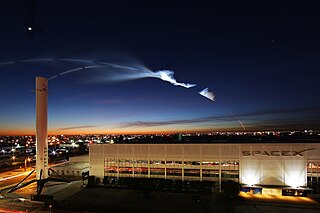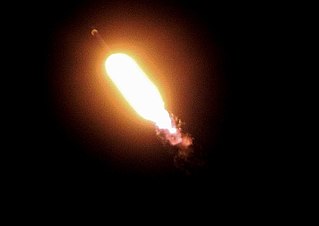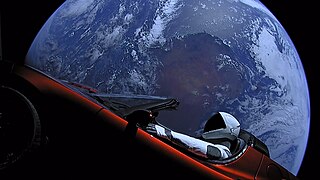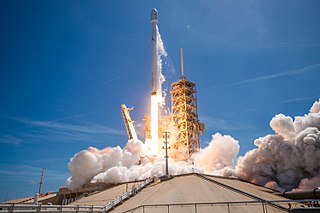
Space Exploration Technologies Corp. (SpaceX) is an American spacecraft manufacturer, launcher, and a satellite communications corporation headquartered in Hawthorne, California. It was founded in 2002 by Elon Musk with the stated goal of reducing space transportation costs to enable the colonization of Mars. The company manufactures the Falcon 9, Falcon Heavy, and Starship launch vehicles, several rocket engines, Cargo Dragon and Crew Dragon spacecraft, and Starlink communications satellites.

Falcon 1 was a small-lift launch vehicle that was operated from 2006 to 2009 by SpaceX, an American aerospace manufacturer. On 28 September 2008, Falcon 1 became the first privately-developed fully liquid-fueled launch vehicle to go into orbit around the Earth.

Falcon 9 is a partially reusable medium lift launch vehicle that can carry cargo and crew into Earth orbit, produced by American aerospace company SpaceX.

SES-8 is a geostationary Communications satellite operated by SES S.A. SES-8 was successfully launched on SpaceX Falcon 9 v1.1 on 3 December 2013, 22:41:00 UTC.
Orbcomm is a family of low Earth orbit communications satellites, operated by the United States satellite communications company Orbcomm. As of July 2014, 51 such satellites have orbited Earth, with 50 still continuing to do so.

Falcon Heavy is a partially reusable heavy-lift launch vehicle that is produced by SpaceX, an American aerospace manufacturer. The rocket consists of two strap-on boosters made from Falcon 9 first stages, a center core also made from a Falcon 9 first stage, and a second stage on top. Falcon Heavy has the second highest payload capacity of any currently operational launch vehicle behind NASA's Space Launch System and the fourth-highest capacity of any rocket to reach orbit, trailing the Saturn V, Energia and Space Launch System.

Several new rockets and spaceports began operations in 2016.

Notable spaceflight activities in 2017 included the maiden flight of India's Geosynchronous Satellite Launch Vehicle Mark III on 5 June and the first suborbital test of Rocket Lab's Electron rocket, inaugurating the Mahia spaceport in New Zealand. The rocket is named for its innovative Rutherford engine which feeds propellants via battery-powered electric motors instead of the usual gas generator and turbopumps.

This article documents notable spaceflight events during the year 2018. For the first time since 1990, more than 100 orbital launches were performed globally.

Planet Labs PBC is an American public Earth imaging company based in San Francisco, California. Their goal is to image the entirety of the Earth daily to monitor changes and pinpoint trends.
Eutelsat 115 West B is a communications satellite that is operated by Eutelsat, providing video, data, government, and mobile services for the Americas. The satellite was designed and manufactured by Boeing Space Systems, and is a Boeing 702SP model communication satellite. It is located at 115 degrees west longitude. It was launched on board a SpaceX Falcon 9 rocket on 2 March 2015.

ABS-3A is a communications satellite operated by ABS, providing coverage in the Americas, Europe, the Middle East, and Africa. It is positioned in geostationary orbit at 3° West, and offers C and Ku-band payload capacity to support video, data, mobility and government applications. The satellite is the first commercial communications satellite in orbit to use electric propulsion, providing a significant weight savings.

Falcon 9 flight 20 was a Falcon 9 space launch that occurred on 22 December 2015 at 01:29:00 UTC. It was the first time that the first stage of an orbital rocket made a successful return and vertical landing.

BulgariaSat-1 is a geostationary communications satellite operated by Bulgaria Sat and manufactured by SSL. The satellite will provide high definition and ultra-high-definition television, very-small-aperture terminal (VSAT) communications, satellite news gathering relays, and other communications services, primarily to the Balkan Peninsula and Central/Western Europe.
SHERPA is a commercial satellite dispenser developed by Andrews Space, a subsidiary of Spaceflight Industries, and was unveiled in 2012. The maiden flight was on 3 December 2018 on a Falcon 9 Block 5 rocket, and it consisted of two separate unpropelled variants of the dispenser.

Falcon 9 B1046 was a reusable Falcon 9 first-stage booster manufactured by SpaceX. It flew four times between 2018 and 2020 before it was expended during a successful abort test of the Crew Dragon. It was the first Block 5 upgrade to the Falcon 9.












